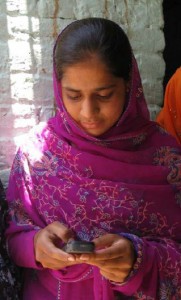
 Just yesterday, International Women’s Day was celebrated; we got little late in getting the approval for publishing this report and preparing our article, but let’s catch the frame before we are too late.
Just yesterday, International Women’s Day was celebrated; we got little late in getting the approval for publishing this report and preparing our article, but let’s catch the frame before we are too late.We had briefly reported about this study“Women and Mobile: A Global Opportunity”, jointly prepared by GSMA Development Fund, Cherie Blaire Foundation for Women and Vital Wave Consulting that focuses on issues like gender gap in mobile phone usage, potential market, prospects with respect to women – with a focus on low and middle income countries.
The report gathered its data through field research, and surveys of 2000 women in four countries (Bolivia, Egypt, India and Kenya). Along with, it took in-depth reviews from telco leaders, organizations working for women, processed case studies from across the world.
Report primarily found:
“A woman is still 21% less likely to own a mobile phone than a man. This figure increases to 23% if she lives in Africa, 24% if she lives in the Middle East, and 37% if she lives in South Asia. Closing this gender gap would bring the benefits of mobile phones to an additional 300 million women.”To narrow down the understanding of behaviors and mobile ownership, researchers divided women, who were surveyed, into five demographic groups, which were:
- Household Income
- Urban /Rural location
- Age
- Occupation
- Education Level
Report found that there are nearly half billion women in low and middle-income countries who access mobile phones through borrowing, while there are another two hundred and fifty million women who are yet to use mobile phone for the first time.

The Mobile Gender Gap
The study, in investigating this mobile ownership gender gap, notes some of the reasons why it exists, and quantifying what the gap means for women around the world:
“To quantify the gender gap, one must understand the breakdown of male and female subscribers. Today, 1.4 billion, or 48% of the 2.9 billion males in low and middle income countries, benefit from mobile phone ownership. In contrast, just 1.1 billion, or 38% of the 2.9 billion females in these countries have mobile phones. This equals a mobile phone gender gap of 300 million women. Of the remaining 3.3. Billion citizens of low and middle-income countries, there are 750 million females, or 26% of all female who could – but do not yet – benefit from mobile communications.” (Meaning that others are outside of mobile network coverage, or are under the age of 14 or over the age of 74).Report states that if telecommunications providers close the gender gap in mobile phone penetration, worldwide telecommunications revenue would increase by US $13 billion.
Report said that South Asia, Middle East and Africa are hot spots for eliminating the gender gap.
Case Studies
Many of the case studies, from across the world, show evidence of the power of mobiles for women in developing countries.
Report discusses a case study of Mobilink Pakistan that worked with UNESCO and a local NGO for the boost of girls’ remote education through SMS. These girls were given low-cost mobile phones and prepaid connections. While teachers were trained to send text messages in Urdu, these girls remained in touch with their courses and interesting information through SMS.
Report says that programme organizers had encountered resistance from portents and community leaders in the start, however, they resistance softened as the locals understood the nature and benefits of programme.
Report notes that exams taken through SMS showed notably good results. Girls and other family members started using other features of mobile phone such as calculator.
Recommendations
The report concludes with an action plan for how to get mobiles to women. It advises:
- To realize this opportunity, that comes with less-numbered mobile ownership of women
- To specifically address women in segmentation strategies and marketing tactics
- Position the phone as a life enhancing and income generating tool
- Understand and operate within a local culture
- Promote the mobile phone as an effective development tool that creates education, health, employment, banking and business opportunities
- Policymakers are advised to “shift the tax burden away from the poorest in society of which women are the majority and create incentives for the development of mobile services that benefit women.”
No comments:
Post a Comment